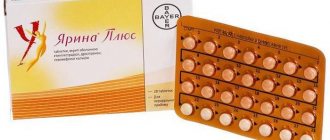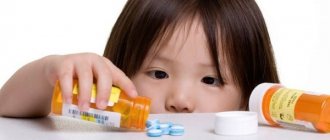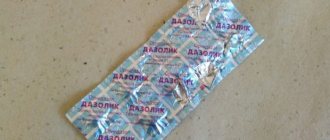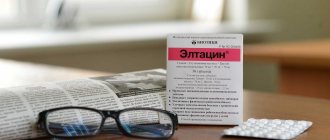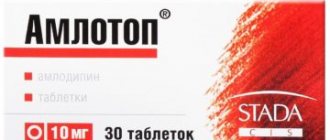Clomiphene citrate (Clomid) is a synthetic non-steroidal drug that resembles estrogen in structure. It is widely used as an ovulatory stimulant. Similar to estrogen, it can bind to estrogen receptors in the hypothalamus. This prevents the hypothalamus from detecting "real" estrogen, and the hypothalamus in turn causes the pituitary gland to release more gonadotropins such as FSH and LH. FSH and LH stimulate the ovaries, the testes, to produce more estrogen in women or testosterone in men.
This property of clomiphene is widely used in the treatment of women with premature ovarian failure and for inducing ovulation. However, long-term use of this drug is unsafe, as it increases the risk of developing ovarian cancer.
pharmachologic effect
In the table you can see the norm of estradiol in the blood.
If the concentration of estrogen in the blood is many times higher than normal, then the drug lowers it. The drug has an anti-estrogenic effect on the woman’s body.
This effect is possible due to the fact that the main active ingredient creates a specific connection between the pituitary gland receptors and the estrogen receptors of the ovaries.
The therapeutic dosage is aimed at enhancing the production of LH and FSH, prolactin.
The drug Clomiphene is also taken to stimulate ovulation. It does not include gestagenic and androgenic effects.
How clomiphene regulates the body's hormonal balance
The content of the article
Clomiphene is often called an anti-estrogen because it inhibits the activity of this female hormone. The action of the drug is closely related to the hypothalamus, a fragment of the brain that is an intermediary between the nervous and endocrine systems of the body. Taking clomiphene leads to selective blocking of estradiol receptors (only these receptors).
Clomiphene, however, stimulates the secretion of FSH (follicle-stimulating hormone). Gonadotropins, produced in excess, constantly stimulate the ovaries. This causes the follicle to grow and mature, which ultimately leads to the release of the egg. In addition to the hormone FSH, another gonadotropin, namely LH (lutropin), which stimulates ovulation, is excessively secreted. Therefore, within 12-24 hours after taking a dose of clomiphene, the probability of fertilization of the egg is very high.
Composition and release form
The drug is available in the form of tablets containing 50 mg of clomiphene citrate each.
The drug Clomiphene
Used as additional substances:
- Gelatin;
- Lactose;
- Magnesium stearate;
- Starch;
- Talc.
Photos of the drug components:
Clomiphene citrate
Gelatin Lactose
Magnesium Stearate Starch
Talc
Similar drugs:
- Postinor Oral tablets
- Clomid Oral tablets
- Escapelle Oral tablets
- Serophene Tablets
- Nolvadex Oral tablets
- Nemestran Capsule
- Buserelin Nasal Spray
- Faslodex Solution for intramuscular administration
- Tamoxifen Hexal Oral tablets
- Aromeston Oral tablets
** The Drug Directory is intended for informational purposes only. For more complete information, please refer to the manufacturer's instructions. Do not self-medicate; Before you start using Clomiphene, you should consult a doctor. EUROLAB is not responsible for the consequences caused by the use of information posted on the portal. Any information on the site does not replace medical advice and cannot serve as a guarantee of the positive effect of the drug.
Are you interested in the drug Clomiphene? Do you want to know more detailed information or do you need a doctor's examination? Or do you need an inspection? You can make an appointment with a doctor - the Euro lab is always at your service! The best doctors will examine you, advise you, provide the necessary assistance and make a diagnosis. You can also call a doctor at home . Euro lab clinic is open for you around the clock.
** Attention! The information presented in this medication guide is intended for medical professionals and should not be used as a basis for self-medication. The description of the drug Clomiphene is provided for informational purposes and is not intended for prescribing treatment without the participation of a doctor. Patients need to consult a specialist!
If you are interested in any other drugs and medications, their descriptions and instructions for use, information about the composition and form of release, indications for use and side effects, methods of use, prices and reviews of drugs, or you have any other questions and suggestions - write to us, we will definitely try to help you.
Indications for use
The drug in tablet form is used for:
- Dysfunctional metrorrhagia;
- Polycystic ovary syndrome;
- Amenorrhea of a secondary nature;
- Galactorrhea;
- Amenorrhea after contraceptives;
- Stein-Leventhal and Chiari-Frommel syndrome.
Photo gallery of testimony:
Dysfunctional metrorrhagia
Polycystic ovary syndrome
Secondary amenorrhea
Galactorrhea Amenorrhea after contraceptives Chiari-Frommel syndrome
For men, Clomiphene is used to activate the release of testosterone, which helps increase the number of active sperm.
Clomiphene and Letrozole
They are not used together
. American scientists have proven that the second drug is more effective in treating infertility than the first.
This is based on a study, according to the results of which 5% more women became pregnant from stimulation with Letrozole than from Clomiphene.
Is clomiphene effective in treating infertility?
Clomiphene is prescribed to women with infertility caused by ovulation disorders and ovulation problems, such as anovulatory cycles, irregular periods, amenorrhea. Clomiphene therapy is recommended for polycystic ovary syndrome and hyperprolactinemia.
Ovulation disorder
The effectiveness of clomiphene therapy is an individual matter, and in many cases results can only be determined after observing several subsequent menstrual cycles. For the vast majority of patients, the maximum duration of treatment with clomiphene is 6 months, after which, if the drug does not produce satisfactory results, consideration should be given to introducing another therapeutic agent or changing the form of treatment. For example, pure gonadotropins are offered as an alternative.
If there is no effectiveness, it is necessary to examine the partner for sterility.
Contraindications
Clomiphene tablets cannot always be taken. There are cases in which its use is contraindicated.
| No. | Contraindications to the use of tablets |
| 1 | Metrorrhagia of unknown origin |
| 2 | Tumors of various types in the genital organs |
| 3 | Gestation period |
| 4 | Ovarian failure due to hyperprolactinemia |
| 5 | Endometriosis |
| 6 | Hypofunction of the pituitary gland |
| 7 | Tumor process in the pituitary gland |
| 8 | Ovarian cyst |
| 9 | Intolerance to active substances |
| 10 | Kidney pathologies |
| 11 | Liver pathologies |
Oral tablets Clomifene
Instructions for medical use of the drug
Description of pharmacological action
An anti-estrogen of a non-steroidal structure, the action of which is due to specific binding to estrogen receptors of the ovaries and pituitary gland. In small doses, it enhances the secretion of gonadotropins: prolactin, FSH and LH. Stimulates ovulation. With a low content of estrogenic hormones in the body, it exhibits a moderate estrogenic effect. With a high estrogen content, it has an antiestrogenic effect. In large doses, it inhibits the secretion of gonadotropins. It does not have gestagenic or androgenic activity.
Indications for use
- anovulatory infertility (ovulation induction); - dysfunctional metrorrhagia; - amenorrhea (dysgonadotropic form); secondary amenorrhea; post-contraceptive amenorrhea; - galactorrhea (against the background of a pituitary tumor); - polycystic ovary syndrome (Stein-Leventhal syndrome); — Chiari-Frommel syndrome; - androgen deficiency; - oligospermia; — diagnosis of disorders of the gonadotropic function of the pituitary gland.
Release form
tablets 50 mg; contour packaging 10, cardboard pack 1; tablets 50 mg; contour packaging 10, cardboard pack 2; tablets 50 mg; contour packaging 10, cardboard pack 3; tablets 50 mg; contour packaging 10, cardboard pack 4; tablets 50 mg; contour packaging 10, cardboard pack 10; tablets 50 mg; dark glass jar (jar) 10, cardboard pack 1; Composition Tablets 1 table. clomiphene citrate 0.05 g excipients: milk sugar (lactose), potato starch, food gelatin, magnesium stearate, talc in a blister pack or in a jar 10 pcs.; in a cardboard pack there are 1, 2, 3, 4 or 10 packages or 1 can.
Pharmacodynamics
An anti-estrogen of a non-steroidal structure, the action of which is due to specific binding to estrogen receptors of the ovaries and pituitary gland. In small doses, it enhances the secretion of gonadotropins: prolactin, FSH and LH. Stimulates ovulation. With a low content of estrogenic hormones in the body, it exhibits a moderate estrogenic effect. With a high estrogen content, it has an antiestrogenic effect. In large doses, it inhibits the secretion of gonadotropins. It does not have gestagenic or androgenic activity.
Pharmacokinetics
When taken orally, it is well absorbed from the gastrointestinal tract. Metabolized in the liver. Subject to enterohepatic recirculation. T1/2 - 5–7 days. It is excreted mainly in bile.
Use during pregnancy
Contraindicated during pregnancy.
Contraindications for use
- hypersensitivity; - liver and/or kidney failure; - metrorrhagia of unknown etiology; - ovarian cyst; - malignant and benign neoplasms of the genital organs; - tumor or hypofunction of the pituitary gland; - endometriosis; - ovarian failure due to hyperprolactinemia; - tendency to thrombosis; - bleeding not associated with ovulation disorders; - pregnancy.
Side effects
From the nervous system: dizziness, headache, drowsiness, slowing of the speed of mental and motor reactions, depression, increased excitability, insomnia. From the digestive system: nausea, vomiting, gastralgia, flatulence, diarrhea. Allergic reactions: rarely - rash, allergic dermatitis, vasomotor disorders. From the genitourinary system: rarely - polyuria, increased frequency of urination, pain in the lower abdomen, dysmenorrhea, menorrhagia, enlarged ovary (including cystic). Other: weight gain, flushing of the face, rarely - decreased visual acuity, alopecia, pain in the mammary glands. The appearance of signs of ovarian hyperstimulation and general side effects requires dose reduction or discontinuation of the drug.
Directions for use and doses
Inside. To stimulate ovulation, prescribe 50 mg 1 time per day before bed, starting from the 5th day of the menstrual cycle, for 5 days (in the absence of a cycle - at any time). If there is no effect (ovulation does not develop within 30 days), increase the dose to 150 mg/day or extend the course to 10 days. The course dose should not exceed 1 g. The development of ovulation is determined by the presence of biphasic basal temperature, an average cyclic increase in LH production, an increase in serum progesterone during the probable middle phase of luteinization or during menstrual bleeding in women with amenorrhea. If ovulation occurs but there is no pregnancy, then the same dose should be repeated during the next treatment course. If menstrual bleeding does not follow after ovulation, the possibility of pregnancy should be taken into account, and this possibility must be excluded before a new course of treatment. Men are prescribed 50 mg 1-2 times a day for 3-4 months (systematic monitoring of spermogram is required).
Overdose
Symptoms: nausea, vomiting, flushing of the face, blurred vision. Treatment: discontinuation of the drug (symptoms of overdose go away on their own).
Interactions with other drugs
Compatible with gonadotropic hormone preparations.
Special instructions for use
Increases the likelihood of developing multiple pregnancies. The drug is effective when the level of endogenous estrogens is sufficient, less effective when the level of estrogens is low and practically ineffective when the concentration of pituitary gonadotropic hormones is low. During the treatment process, constant supervision by a gynecologist is necessary; ovarian function should be monitored, vaginal examinations should be performed, and the “pupil” phenomenon should be observed. During the treatment period, care must be taken when driving vehicles and engaging in other potentially hazardous activities that require increased concentration and speed of psychomotor reactions.
Storage conditions
List B: In a dry place, protected from light, at a temperature not exceeding 25 °C.
Best before date
36 months
ATX classification:
G Genitourinary system and sex hormones
G03 Sex hormones and modulators of the reproductive system
G03G Gonadotropins and other ovulation stimulants
G03GB Synthetic ovulation stimulants
G03GB02 Clomifene
Side effects
Taking the drug in tablet form can cause adverse reactions.
| No. | Organ system name | Adverse reaction |
| 1 | central nervous system | - Overexcitability; - Feeling tired; - Dizziness; - Insomnia; - Severe headache. |
| 2 | Endocrine system | — Weight gain; - Polyuria; - Pollakiuria; - Excessive sweating; - The ovaries are enlarged in size; - Ovarian cyst; — Pain in the area of the uterine appendages; - Heavy discharge during menstruation. |
| 3 | Digestive system | — Heaviness in the epigastric zone; - Flatulence; - Nausea; - Vomit. |
| 4, | Allergic reactions | - Urticaria; - Dermatitis. |
| 5 | Other | - Hot flashes; - Feeling of heaviness in the chest; — Mild alopecia; - Visual impairment. |
Side effects of the drug Clomiphene
dizziness, headache, nausea, vomiting, depression, fatigue, excitability, insomnia, weight gain, pain in the lower abdomen, vasomotor symptoms and visual impairment (disappear after completion of treatment). Rarely, cystic enlargement of the ovaries is possible, especially with Stein-Leventhal syndrome (the ovary can enlarge up to 4–8 cm), therefore, during treatment, basal temperature should be regularly monitored and if biphasicity appears, clomiphene should be discontinued. With long-term therapy, reversible hair loss may increase. Sometimes there is a skin rash or allergic dermatitis, pain in the mammary glands, dysmenorrhea, polyuria and pollakiuria, multiple pregnancy.
Instructions for use
To develop ovulation, the drug is taken for 5 days, 1 tablet.
You need to start on the 5th day of menstruation, and if not, then whenever. It is better to take the pill before bed.
If at this dosage ovulation does not occur within 30 days, then the dose is increased 3 times, that is, 150 mg. They may also extend the initial therapy by 10 days.
For men, Clomiphene tablets are recommended to take 1 to 2 tablets per day for 3 to 4 months.
How to take clomiphene
Most often, doctors choose the drug in tablet form because it is more convenient for patients. By default, clomiphene is prescribed at a dose of 50 mg per day. Therapy should begin on a certain day of the cycle (days 3-5). After 5 days of regular use of the drug, there is a break - waiting for ovulation, which, with effective treatment, should appear in about 10 days.
Treatment with clomiphene is carefully monitored by a doctor who repeatedly performs diagnostic ultrasounds to study the maturation of the eggs. Subsequent morphology is recommended to determine the level of sex hormones.
Analogues substitutes
You can replace the tablets with the following medications:
- Clomid;
- Pergotime;
- Serpafar;
- Clostilbegit;
- Serophene.
Photos of analogues:
Clomid
Pergotime
Serpafar
Klostilbegit
Serophene
Which is better Clomiphene or Tamoxifen, Clostilbegit?
Tamoxifen is used in the presence of breast cancer in both men and women or metastases.
The first and third drugs are used for similar indications and are substitutes for each other.
Clostilbegit is much easier to find in pharmacies than Clomiphene tablets.
What to look for when treating with clomiphene?
Some precautions should be taken during treatment with clomiphene. It is very important to regularly evaluate the size of the ovaries using ultrasound, as well as their morphology for possible cystic changes.
If the doctor sees an abnormal ultrasound image, treatment should be stopped and continued only after these changes have resolved. Then it is recommended to reduce the therapeutic dose of the drug. Do not underestimate visual impairment. Deterioration of visual acuity after clomiphene is an indication for discontinuation of the drug and ophthalmological consultation.
A serious side effect is called ovarian hyperstimulation syndrome. The condition is characterized by the following problems:
- pericardial/pleural effusion;
- swelling of the subcutaneous tissue;
- acute stomach;
- renal failure;
- ovarian torsion or hemorrhage into the ovary.
Particular attention should be paid to the group of patients diagnosed with uterine fibroids, since treatment with clomiphene can lead to an increase in the tumor.
Reviews and results
Angelica, 37 years old : “My husband and I lived together for 12 years and never had children. At first they didn’t want to, but when they matured, it didn’t work out. We decided to see a doctor and it turned out that the reason was me. They prescribed me to take Clomiphene tablets to stimulate ovulation. At first it did not work, but then it finally bore fruit. Another 2 months of patient waiting and we will become parents.”
Martha, 39 years old : “I already have one child. But, I really want to feel the joy of motherhood again and hold my baby in my arms! My husband and I tried our best, but we couldn’t get pregnant. The doctor said that my husband did not have enough active sperm. Prescribed Clomiphene. Now he uses it and his tests seem to be better. Let's hope we give birth again."
Mechanism of action of clomiphene
Clomid is a powerful drug. However, if the correct dosage is followed and the treatment is short, it can help with female infertility. Clomiphene acts similarly to estrogens. It interacts with estrogen receptors in the hypothalamus and blocks these areas. In this case, the brain receives a signal that there is insufficient amount of the hormone estrone in the body. This causes an increase in the level of gonadotropins, which increase the stimulation of the ovaries to produce estrogen. This leads to the synthesis of the hormone in both the adrenal glands and the ovaries. Increasing estrogen levels is important for the fertilization process.

